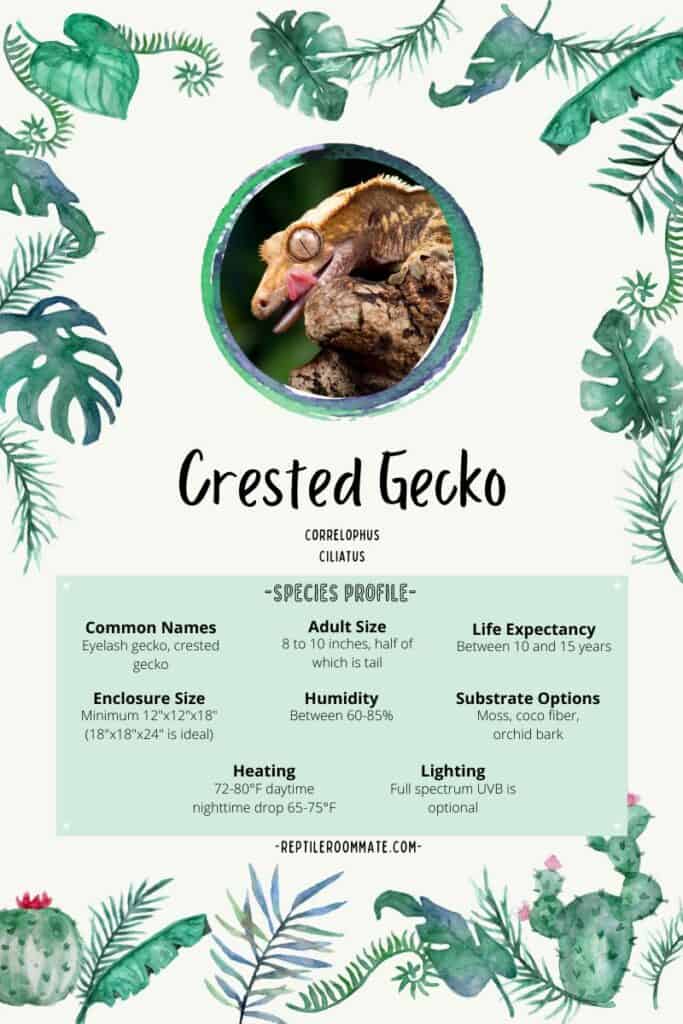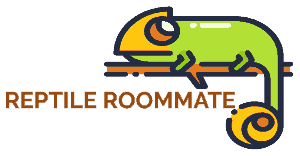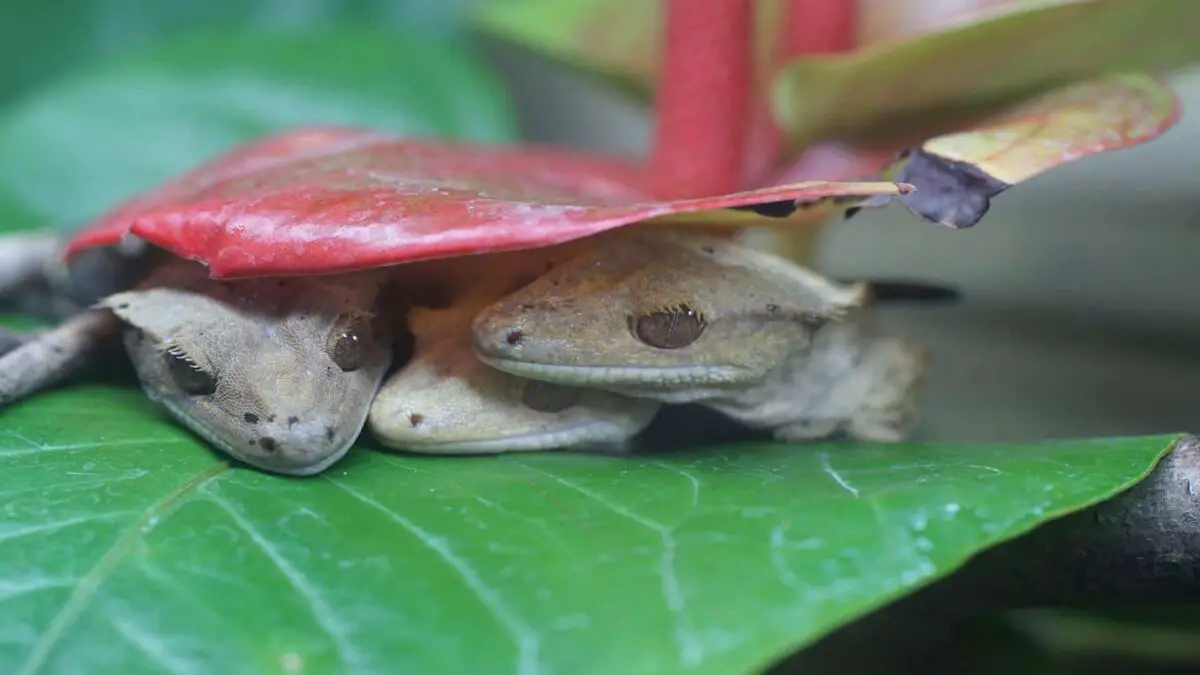Comprehensive Crested Gecko Care Guide
Crested geckos are extremely popular pet reptiles, and for good reason! Crested geckos are hardy and easily cared for, readily available in many colors and patterns, and are absolutely adorable; a sure winner for any reptile lover!
This crested gecko care guide will provide you with all the information that you need to successfully setup, maintain, and care for a pet gecko.
Reptile Roommate is a participant in the Amazon Services LLC Associates Program. As an Amazon Associate I earn from qualifying purchases.

Crested Geckos In The Wild
Crested geckos are from New Caledonia, an island in the Pacific Ocean Northeast of Australia.
They live in this mild tropical climate in the lowland rainforest. The temperature rarely exceeds 80°F. They use their toes and semi-prehensile tail to aide in climbing high up into the canopy created by the treetops.
Crestie Size and Coloration
Crested geckos range in size from about 8-10 inches in total length, approximately half of which is their tail.
These geckos are also known as “eyelash geckos” because of the hair-like projections around their eyes that look like eyelashes. They also have spines that form at the sides of their heads and run to the base of their tails.
The life span for crested geckos are, on average, approximately 10-15 years, although well-taken care of individuals can live 20 years or more!
Crested geckos have many naturally occurring color morphs, various shades of grey, brown, red, orange, and yellow.
They also have variations in pattern, head size, and crest size/abundance.
Breeders have taken advantage of all of these naturally occurring morphs and differences to breed a spectacular array of colors, patterns, and head/crest sizes for geckos keepers to enjoy!
You will not have a difficult time finding the “perfect” crested gecko to suit any taste!
Are Crested Geckos Good Pets?
Crested geckos are great for beginner and experienced reptile keepers!
Their setup and care is simple and they can be very forgiving of even novice mistakes.
Some argue that crested geckos are even an “better first reptile pet” than leopard geckos.
Crested Gecko Behavior and Temperament
Crested geckos are crepuscular; they become active during dawn and dusk. They will be most active at these times. During other times and mostly throughout the day, your crested gecko will be hiding or sleeping.
It is normal for them to be a bit sluggish, not moving around or climbing, or even be completely hidden! This is especially true of you have strong lighting or have their enclosure in a high-traffic area of your home.
Don’t worry this is normal crested gecko behavior. They are most likely hiding in the decorations, leaves, or hideouts that you’ve provided.
Sometimes you will find your gecko burrowing or digging in the substrate; this is normal behavior as well. Sometimes they just want to find a bit of a “cool place” to go for awhile. It also could be signs that a female is looking to lay eggs!
Since crested geckos have no eyelids so you’ll see them moistening their eyes by frequently licking them with their tongues.
Crested geckos (or “cresties” for short) can also climb smooth surfaces with ease. They are excellent jumpers!
You may hear your crested gecko ‘chirp’ and ‘squeak.’ They are quite vocal so don’t be surprised if you hear your gecko “talking” to you!
Do Crested Geckos Have Teeth?
Believe it or not, crested geckos DO have teeth! ..and a lot of them! Crested gecko mouths are filled with tiny, albeit quite dull, little teeth! These tiny teeth aren’t used for chewing but instead aid in holding onto insect prey and assist in feeding.
Do Crested Geckos Bite?
Crested geckos are known for being quite docile and can tame readily with consistent handling. Crested geckos aren’t very aggressive (unlike tokay geckos) and a bite from one is rare.
However, most animals with “defend” themselves when they feel threatened. One of the last-resort defenses for a crested gecko is to bite.
No fear though, a bite from an adult crested gecko is nothing to be worried about. It’s more like a small pinch and the most dramatic thing about it is that it might scare or surprise you rather than hurt you.
If the bite draws blood (rare) just make sure to clean the area well by washing and cover it with a small bandage.
Do Crested Geckos Like To Be Held?
Crested geckos take well to handling and are seldom bothered by being picked up. They can and do however have the ability to jump; and what great little jumpers they are!!
It’s important to set aside time to handle your crestie regularly, especially when you first get it, in order to develop trust and help tame it.
Like many geckos they do need to be handled with care. Never pick up or hold your crested gecko by the tail!
Do Crested Gecko Tails Grow Back?
Crested geckos can drop their tails when threatened of frightened. This is called caudal autotomy. Once a crested gecko drops its tail, it’s gone for good! Unlike other their cousins the leopard and gargoyle geckos, crested geckos do not regrow their tails.
While a crested gecko may not drop its tail unless threatened or restrained in some way, sometimes crested geckos drop them for what seems like no good reason.
This is something that crested gecko owners have come to accept and even appreciate. It’s just part of having a crested gecko. Many, many crested gecko owners have at least one gecko without its tail.
Crested Gecko Enclosure
Being semi-arboreal lizards crested geckos do great in enclosures that are tall or have good height so that they can climb and jump.
A 18″ x 18″ x 24″ enclosure (minimum for a pair or females) is a great size for a single adult. The height of the enclosure is more important than the length.
Live plants can provide excellent hiding spots and opportunity to drink water droplets from their leaves.
You also want to be sure that your enclosure has a secure screen lid or top (mostly to keep other things out rather than your crested gecko in) that provides adequate ventilation and support for a light if needed.
The Best Live Plants For Crested Geckos
- Pothos a rapidly growing vine with green variegated coloring and large leaves that are great for climbing and cover.
- Snake plants slow-growing with vertical “sword-like shoots” that are varying colors of green with or without stripes. These sword-like leaves are very study and create excellent cover and hiding spots for crested geckos.
- Bromeliads Popular terrarium and house plants, bromeliads do not require soil; they can be wedged in between wood branches or stones in your gecko’s enclosure. They have sturdy leaves with incredibly colored “special leaves” that almost resemble flowers!
- Ferns varieties such as button and bird’s nest ferns make great additions to most terrariums; crested gecko terrariums included!
- Crotons sturdy, highly variegated and dazzling colors! Crotons are beautiful plants that can bear crested geckos’ weight and propensity to jump from leaf to leaf!
How Many Crested Geckos Can Live Together? Can Crested Geckos Live Together?
There is One Golden Rule for housing crested geckos; DO NOT house males together. They will fight, they will hurt each other and BOTH will suffer, possibly even die.
Females of similar size can potentially live together; approximately 2-3 females in a (minimum) 18″ x 18″ x 36″ enclosure. Remember height is more important than surface area.
Just keep in mind that the more geckos you have the larger the enclosure and the more hides that you’ll need. Crested geckos will appreciate an enclosure that provides many branches, leaves, and vines to climb on.
Having crested geckos living together isn’t as simple as it may seem. There are quite a few considerations to consider.
Humidity for Crested Geckos
Your crested geckos will require a constant humidity of 60%-85%.
Maintaining such a humidity will require you to mist the geckos enclosure, sometimes multiple times a day.
Using a hydrometer, a device for measuring humidity is a must with crested geckos. Fortunately they are inexpensive and readily available.
The Best Substrate For Crested Geckos?
The substrate needs to retain moisture to help keep the humidity in the desired range.
Substrates such as moss, coco fiber, orchid bark, or even something as simple as paper towels can be great.
Avoid using sand or soil containing pesticides or fertilizers. Two fo our favorites are Galapagos Terrarium Sphagnum Moss and Zoo Med Forest Floor Bedding.
Crested Gecko Temperature
A daily daytime temperature between 72-80°F is perfect for crested geckos. A night time drop in temperature to 65-75°F is ideal.
Average household temperatures coincides with this night time temperature (65-75°F) so you most likely only need heating for your enclosure’s daytime temperatures.
Heating
The most effective means of heating your crested geckos enclosure is by using a ceramic heat emitter or low-watt red heat bulb.
Remember that crested geckos don’t like high temperatures (higher than most average household temperatures anyway) so heating elements or lamps don’t need to be extremely powerful.
Do not use heating rocks or stones that go inside of your enclosure. These can cause severe burns for your gecko.
Lighting
While not necessary, a low output UVB light can be beneficial as well as visually appealing to the colors and patterns of your gecko.
That said, lighting is much more for your enjoyment than your geckos.
Place a simple low-watt light overhead or on the screen cage top for 8-12 hours a day.
Crested Gecko Care Checklist
- Suitable enclosure (tank, terrarium, etc)
- Plants, branches, and vines for climbing
- Substrate (retains moisture)
- Heating
- Lighting (UVB not necessary)
- Thermometer and hydrometer (calculate temperature and humidity)
Crested Gecko Food and Water
Water should be available at all times. A shallow, stable water dish should be provided. It should not be too deep that your gecko cannot easily crawl out of it.
Crested geckos will drink from standing water but they will also hydrate themselves by licking water droplets from leaves when you mist they enclosure.
Crested geckos are omnivores; they a combination of plant and animal-based foods. Most crested gecko keepers give their geckos a commercially available diet along with the occasional insect feeding.
Meal Replacement Powders
Commercially available meal replacements (LINK) such as Pangea Fruit Mix Complete and Repashy Superfoods MRP are powders that you add water to and mix to a paste-like consistency which you then feed to your geckos.
Some crested gecko owners forgo the prepared meal replacements and feed their geckos insects along with fresh fruit. Fruits such as banana, papaya, mango, strawberries, and watermelon are some examples. Smash or pulverize them to a consistency that can be easily eaten by the geckos.
Feeder Insects
You can supplement your crested gecko’s diet with crickets, small feeder roaches, and wax worms.
All insects should be “gut-loaded” prior to being fed to your crested gecko. Gut-loading is accomplished by feeding the insects nutritious food for at least 24 hours before they are fed to your gecko. Things like fresh vegetables, fruits, tropical fish flakes, and commercial reptile food are insect feed.
Before feeding your gecko, feeder insects should be “dusted” with specially formulated calcium, vitamin, and mineral powders. This is as simple as sprinkling a bit of powder on the insects to be fed before feeding them to your gecko. Just make sure that you don’t have an excess of powder getting all over your gecko’s enclosure or in the gecko’s eyes.
Adult crested geckos should be fed three times a week with juveniles being fed daily.
Shedding in Crested Geckos
As crested geckos grow they need to shed their old skin to make room for the new growth.
Fortunately shedding is something that crested geckos usually handle with ease. Crested geckos will eat their shed skin.
The main thing you must do as a pet owner is provide them that sweet-spot of 65-85% humidity and they will take care of the rest.
However, if you gecko does show signs of a stuck shed (many times on the toes) have them soak in slightly warm water for a while and help them by rubbing the stuck shed gently with a Q-tip.
Notice that I bolded the word “rubbing.” The last thing you want to do is force or pull at stuck skin. Give it some time in the warm water and be patient.
Common Health Problems
One of the most serious and common afflictions that a crested gecko can suffer is metabolic bone disease (MBD). Crested geckos need calcium in their diet (the reason for dusting their food) and if they don’t get enough calcium and vitamin D it can cause a host of spine and limb deformities.
Impaction is another serious and all too common health problem for crested geckos. Eating and ingesting substrate is the main cause of impaction. Feeding your gecko a meal that is far too large to be eaten easily can also lead to impaction.
Prolapses, parasites, (especially from wild caught individuals) and burns (from the use of heat rocks or lamps) are also serious problems facing these geckos.
If you have any questions or concerns about your crested geckos health please contact your local veterinarian!
We hope this care guide will answer some of your questions, provide you with a resource for information, and help you maintain a happy and healthy crested gecko!


